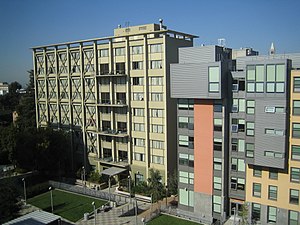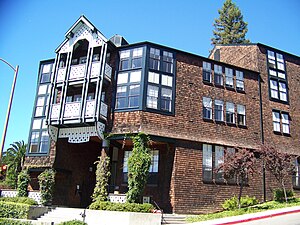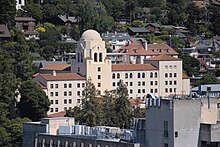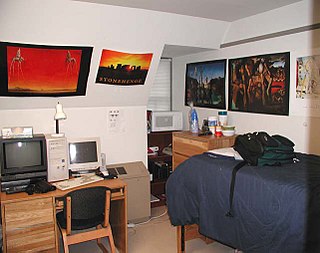
A dormitory, also known as a hall of residence or a residence hall, is a building primarily providing sleeping and residential quarters for large numbers of people such as boarding school, high school, college or university students. In some countries, it can also refer to a room containing several beds accommodating people.

The Cloyne Court Hotel, often referred to simply as Cloyne, is a historical landmark in Berkeley, California and currently one of the houses of the Berkeley Student Cooperative (BSC), a student housing cooperative. It is located at the north side of the University of California, Berkeley campus at 2600 Ridge Road, near Soda Hall and Jacobs Hall, and is the next door neighbor of the Goldman School of Public Policy.

Revelle College is the oldest residential college at the University of California, San Diego in La Jolla, California. Founded in 1964, it is named after oceanographer and UC San Diego founder Roger Revelle. UC San Diego—along with Revelle College—was founded at the height of the Space Race between the United States and the Soviet Union. As a result, the initial class of 181 undergraduates comprised only 30 non-science majors. Revelle College focuses on developing "a well-rounded student who is intellectually skilled and prepared for competition in a complex world."
The Berkeley Student Cooperative (BSC) is a student housing cooperative serving primarily UC Berkeley students, but open to any full-time post-secondary student. The BSC houses and/or feeds over 1,300 students in 17 houses and three apartment buildings. Food is provided to residents of the 17 houses, which also offer boarding meal plans to non-residents. As part of their rental agreement, residents of the houses are required to perform workshifts, typically five hours per week. The BSC is led by a board of directors which is primarily composed of and elected by student members.

Kingman Hall is located at 1730 La Loma Avenue near the northeast corner of the University of California, Berkeley campus. As part of the Berkeley Student Cooperative, Kingman Hall houses 50 residents, known as Kingmanites or Toadies. It is named after Harry Kingman, the former YMCA director who in 1933 inspired 14 students to start a student cooperative. The house was designated a City of Berkeley Landmark in January 1999.
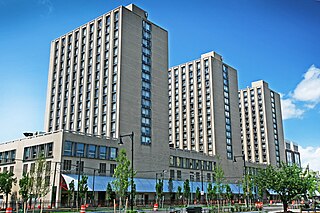
The Boston University housing system is the 2nd-largest of any private university in the United States, with 76% of the undergraduate population living on campus. On-campus housing at BU is an unusually diverse melange, ranging from individual 19th-century brownstone town houses and apartment buildings acquired by the school to large-scale high-rises built in the 60s and 2000s.

UC Village, also called University Village or University Village Albany, is a housing community for students and postdocs who are married or have dependents. It is owned and administered by the University of California, Berkeley. It is located within the city limits of Albany about two miles away from the main Berkeley campus, at an elevation of 26 feet. It was originally known as Codornices Village, and later, Albany Village. It is also commonly referred to as The Village.
Student housing at the University of California, Irvine, is separated between first-year students, continuing students, graduate students, and faculty. These accommodations serve the traditional purpose of housing residents and serve as a long-term outreach incentive for first-year students and faculty. Student housing also plays a crucial role in developing campus-wide social activities.

Student housing owned by the University of California, Los Angeles is governed by two separate departments: the Office of Residential Life, and Housing and Hospitality Services, and provides housing for both undergraduates and graduate students, on and off-campus.

The upper campus residence halls at the University of Pittsburgh include Sutherland Hall, Panther Hall, K. Leroy Irvis Hall, the fraternity housing complex, and the Darragh Street Apartments. Among the newest residence facilities at the university, these buildings reside on the upper campus located near many of the school's athletic facilities. The upper campus resides approximately 200 feet (61 m) above the lower campus that lies along Forbes and Fifth Avenues, providing dramatic views along the hilltop and slopes. Planning for upper campus student housing originated in the late 1960s and early 1970s, but stalled due to community and political opposition until the early 1990s with opening of Sutherland Hall, the first major student residence constructed by Pitt in 29 years.

The Pymatuning Laboratory of Ecology (PLE) is a year-round ecology field station of the University of Pittsburgh Department of Biological Sciences located in Linesville and South Shenango Township on the shores Pymatuning Lake in Pennsylvania. The station contains research facilities and equipment, conducts undergraduate education and courses, and serves as center for conferences, symposia, and retreats. The Pyatuning Laboratory hosts researchers from the University of Pittsburgh as well as those from universities throughout the nation and world, which have included, among others, researchers form Duke University, the University of Virginia, the University of Georgia, the University of Miami. Likewise, course instructors at the lab come from the University of Pittsburgh, but also have included instructors from other institutions including Georgia Tech, the University of Connecticut, and the National Aviary. In addition, the University of Pittsburgh has instituted a collaborative program for study at the Pymatuning Lab with other area universities in which students that are enrolled through any of these institutions register, pay tuition, and receive credit at their home institutions. Schools participating in the collaborative program include Clarion University, Edinboro University, Indiana University of Pennsylvania, and Slippery Rock University.
George W. Chang is a professor and a resident faculty member at the University of California, Berkeley. He resides on campus with his wife Abby, while he is currently an Associate Professor Emeritus in the Department of Nutritional Sciences and Toxicology.

The residence hall system at the University of Central Florida in Orlando, Florida is administered by the Department of Housing and Residence Life. As of 2011, the system offers just under 6,500 beds on its main campus within five housing communities, 400 beds at the Rosen College of Hospitality Management, and 3,750 beds in university-affiliated housing.
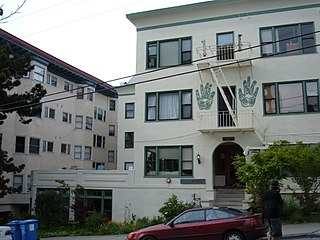
Stebbins Hall is a student housing cooperative owned by Berkeley Student Cooperative (BSC) and located at 2527 Ridge Road in Berkeley, California, on the Northside of the University of California, Berkeley campus. The house has a total occupancy of 64 residents during the school year, from late August to mid-May, and can accommodate upwards of 54 residents over the summer.
Housing at the University of Georgia is managed by the Department of University Housing. On campus housing for undergraduate students is divided into nine communities, and for graduate students into three communities.
Since the founding, Stanford University has provided on-campus housing for students. Today, all undergraduate students, most graduate students, and many graduate employees use campus housing. While not all graduate students are eligible for campus or subsidized off-campus housing, of those that are, only 64% are able to take advantage of this opportunity due to the limited housing stock. Student Housing at Stanford is currently part of Residential & Dining Enterprises, an in-house standalone vendor within the Stanford affiliated network of businesses.
Stony Brook University is the largest residential campus in the State University of New York system, with approximately 54.5% of its students living on campus. Housing at Stony Brook is issued and controlled by Stony Brook University Campus Residences, which provides 9,445 spaces in its 11 corridor style buildings, 19 suite style buildings, and 23 apartment style buildings to Undergraduate students, Graduate students, and students' families. The large majority of on-campus housing is provided to students on the university's west campus, but housing is available to those on east campus, and for Stony Brook Southampton students.
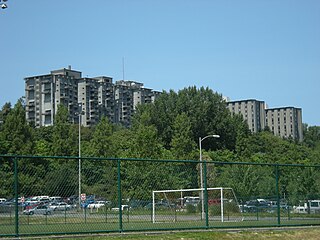
Housing at the University of Washington is administered by the Housing & Food Services (HFS) department at the University of Washington. Undergraduates are housed primarily in residence halls located on North Campus and West Campus. Typically, residence halls are 9-month spaces for undergraduate students. However, there are also 12-month apartment spaces available for undergraduate students. Graduate and professional students are provided the option to live in 12-month apartments operated either by the university or privately. The University of Washington does not require students to live on campus. Although students are not required, about 71% of freshmen choose to live on campus. Housing is not guaranteed but placement in the residence halls is guaranteed for returning residents. Most winter quarter and spring quarter applicants are assigned housing. There are also three family housing options for registered full-time students at the Seattle campus.


